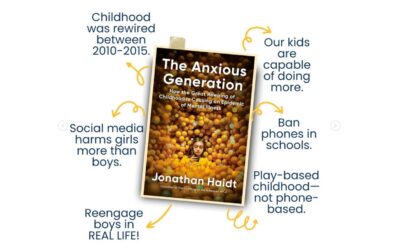One of my favorite parenting mentors, Rachel Macy Stafford, recently published an article on her site, handsfreemama.com, that really captures what our goal is at Better Screen Time. We want to learn to set limits so we can connect with our children and look into their eyes more. Rachel gave us permission to share part of her post here.
Set This Simple Limit to Expand Connection, Close Gaps, and Get Life Immediately Looking Up

On many afternoons, a fourth grader in the neighborhood greets my middle school daughter on her way home from the bus stop.
“Hello, Avery,” the boy says, stopping in the middle of his kickball game with friends to inquire about her day. He then waits patiently to listen to her response.
The reason I know this is not because I see it; I know this only because my daughter told me. My perceptive girl knows this is a rare and noteworthy gesture in our fast-paced, head-down, inwardly focused culture.
But what Avery said after she told me of this warm greeting has stuck with me for weeks. She said, “He’s one of those people who won’t change when he gets a phone.”
This is a valuable observation from a young person who is living the BEFORE & AFTER of phone acquisition. Over the past year, many of Avery’s peers have gotten phones, and she’s noticed a change.
Conversation decreased.
Focus diminished.
Attention shortened.
Cues missed.
Empathy reduced.
And in some instances, personalities altered.
My daughter’s observations align with current research findings on the negative impact of a phone on social and emotional wellbeing and relationships. (sources: Smartphones Lower Conversation, Missing Your Children’s Cues, Constantly Checking Your Phone)
Although I keep up with current research, I have yet to find anything I don’t already know. Once you’ve lived life tethered to your phone, you already know the effects, the damage, and the cost.
Perhaps that is why The Phone Effect is so noticeable to my daughter. For two solid years of her young life, Avery experienced the painful phenomenon of being right next to someone, yet being invisible.
It all started out so innocently—I was taking teaching recertification classes, caring for my young daughters while my husband traveled for work, trying to fit into my new neighborhood through active community involvement. But what was once a way to pass time and remain on top of things became habitual behavior.
Before I knew what hit me, I was a moody, distracted, stressed out, critical observer of life—missing all the moments that truly mattered.
It took two years of misery, one painful truth from my husband, a look of fear in my child’s eyes, and an emotional breakdown while out on a run to acknowledge I was not the person I wanted to be. With certainty, I knew that if I continued on this course, my relationships, my health, and my life would be damaged beyond repair.
I’ll never forget the first step I took to take back my life.
I was in the middle of making lunches when I looked up and noticed then four-year-old Avery sitting on the couch.
Despite the dinging notifications on my phone, the open browsers on my laptop, and the mile-long to do list staring me down, I knew I had to hold my child.
I felt a profound sense of urgency pounding in my chest—like time was running out, and there was nothing more important than being with her right then.
After holding her close for several minutes, Avery picked up my hand and kissed my palm.
How can I correct the damaging course I am on? I’d cried out on my morning run.
The response could not have been simpler.
Let go of what DOESN’T matter, so you can grasp what DOES.
Click here to read how Rachel learned to set limits in order to make this happen. This isn’t just about the kids, it’s about us, the parents, leading the way.



